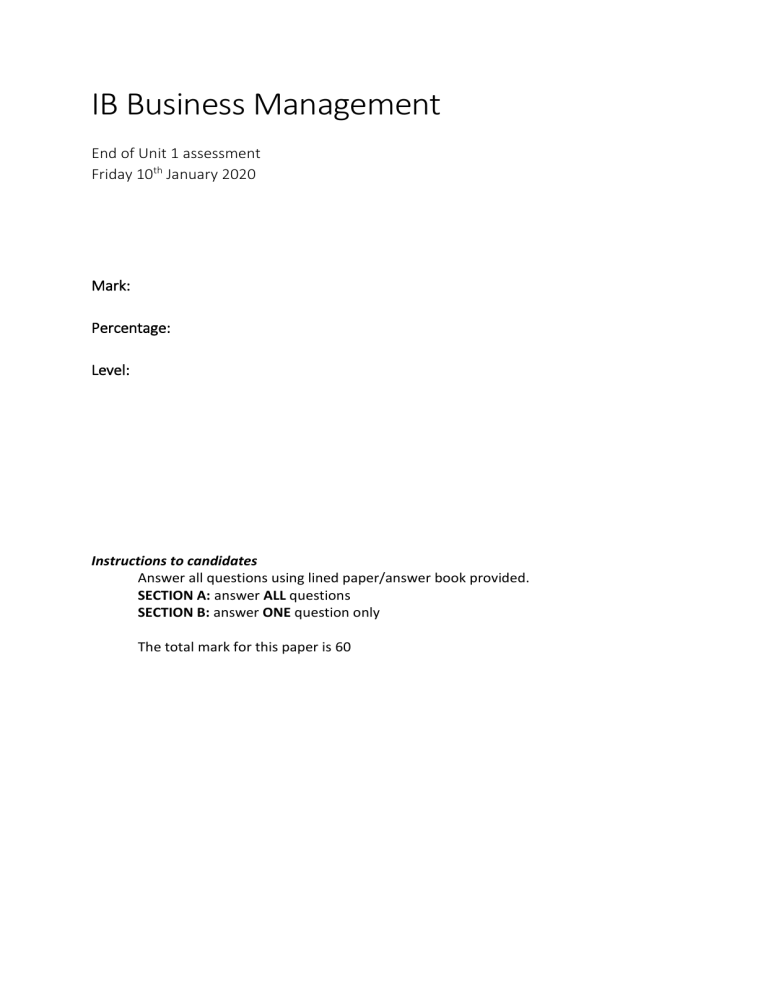
IB Business Management End of Unit 1 assessment Friday 10th January 2020 Mark: Percentage: Level: Instructions to candidates Answer all questions using lined paper/answer book provided. SECTION A: answer ALL questions SECTION B: answer ONE question only The total mark for this paper is 60 SECTION A (answer all questions) Chapter 1: Introduction to business management 1. Explain what a business is and what it does. [4] 2. Outline the four main business functions of any business. [4] Chapter 2: Types of organisation 1. Explain the concept of limited liability. [3] 2. Using concepts such as ownership, control, sources of finance, liability of owners and the advantages and disadvantages of each, distinguish between sole traders and partnerships. [5] 3. Using concepts such as ownership, control, sources of finance, liability of owners and the advantages and disadvantages of each, distinguish between private limited companies and public limited companies. [5] Chapter 3: Organisational objectives 1. Explain the importance of setting objectives in managing an organisation. [4] 2. Explain the purpose of mission statements and vision statements. [4] 3. Distinguish between objectives and strategies with reference to how they interrelate with each other. [5] Chapter 4: Stakeholders 1. Explain what is meant by ‘stakeholder’. [3] 2. Distinguish between internal and external stakeholders [4] 3. Discuss possible areas of conflict between two stakeholder groups and how might the conflict be resolved. [6] SECTION B (answer 1 question only) Chapter 5: Growth and evolution Read the case study and answer the questions that follow. Fashionista ® Plc. Produces women’s corporate and smart casual wear and sells their ranges to major retailers in several countries. Sales turnover has grown by around 10% each year from the last decade – a slower rate than some competitors. Fashionista® is price competitive in the quality of its products and its target market – corporate and professional women. They have been able to keep prices affordable, even while investing heavily in their brand and developing a product range that is differentiated from its major competitors. Cost control has been achieved by opening low-cost factories in Vietnam and Bangladesh, allowing it to achieve greater economies of scale. The internal growth strategy was supported by most of the directors. They believed it had been achieved without excessive external borrowing. There were some real causes for concern, however. Sales revenues were increasing, but profits had remained unchanged for the last two years. This was due to several factors. First, new lower priced competitors were entering the corporate wear market, many of whom were able to provide a good, basic quality product (e.g., merino and cashmere blazers and skirts). Secondly, raw material prices for both natural and manmade inputs were rising. Lastly, the number of mergers, takeovers, joint ventures and strategic alliances between large clothing retailers had increased their bargaining power when dealing with producers like Fashionista®. Major shareholders in Fashionista® were not happy with the directors’ growth strategy. At the last board meeting, the finance director, Emily Zhou, proposed a policy of rapid external growth. She argued that this could be achieved by aggressive takeovers of either clothing producers or material suppliers to achieve greater economies of scale, lower prices, and greater profit margins. The marketing director, Kate Macrae suggested focussing on a smaller, higher-income market segment. This could be reinforced with a joint venture or a merger with a clothing retailer, such as Max™. “Our own shops will give us real power in the high street as we will be able to offer customers a top-quality shopping experience – this will allow us differentiation in a crowded market”. The chief executive, Abbey turner, suggested that both directors prepare a detailed report on these proposals. A. Explain the difference between ‘internal’ and ‘external’ growth. [4] B. Explain three different economies of scale [6] C. Evaluate the use of a joint venture or a merger as a growth strategy by fashionista® providing clear advantages and disadvantages of each. [8] Chapter 7: Organisational planning tools Read the case study and answer the questions that follow. Bowlarama is a company that offers franchises to set up bowling alleys that provide affordable bowling for families. It is planning to open a bowling alley in the central area of Sydney, Australia. The aim is to keep the number of staff employed to a minimum. The only staff needed are those needed for security, safety and cleaning. Slot machines give change and dispense equipment. The bowling lanes are booked using the internet or machines located in the foyer. Refreshments are only available using vending machines. Shoes are automatically cleaned. Abbey Turner is interested in buying a Bowlarama franchise. Research shows that there are a large number of young people in central Sydney with high levels of disposable income and that there are not many bowling alleys. There are, however, leisure facilities and other attractions in the city which are very popular with residents and visitors. The three sites that Bowlarama are considering are quite wealthy and house prices are rising steadily. Unemployment is low and the standard of education is good. Abbey currently manages another leisure facility and has a lot of contacts in the entertainment industry. Abbey’s management style is very personable and people find it easy to talk to her about their problems. She lacks skills in dealing with her finances and prefers to pay an accountant to make sure her accounts are in order. The forecast costs and revenues of each franchising option is given below. OPTION Site A= limited parking, easy building site Site B= less foot traffic, difficult building site Site C= largest bowling alley development FORECAST COSTS FORECAST REVENUES IF SUCCESSFUL PROBABILITY = 0.3 FORECAST REVENUES IF NOT SUCCESSFUL PROBABILITY = 0.7 $400,000 $1,900,000 $200,000 $500,000 $1,600,000 $400,000 $640,000 $2,100,000 $420,000 a. Explain the value to a business of using the following organisational planning tools: i) Decision trees ii) Force field analysis iii) Fishbone diagrams [6] b. Prepare a decision tree based on the above options, adding the payoffs and probabilities. [6] c. Calculate the expected value of the three options and select most appropriate site. [6]
